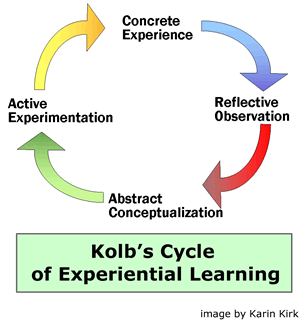Reflecting on experiential education
Geneviève Maheux-Pelletier
At York, Experiential Education (EE) is defined as “[t]he application of theory to a concrete experience, either within the classroom or within the community, which advances the learning outcomes of a course or program and requires students to reflect upon their learning.” Kolb’s model of experiential learning (Kolb, 1984) is the theoretical basis of York’s approach to EE, conceptualized as an iterative, learner-centred process of knowledge construction where the starting point is a concrete experience. Learners then reflect on their observations to make sense of their experience before extracting broader meaning and thinking in more abstract terms. Last, learners use what they learned to experiment and plan next steps and assimilate new experiences, as represented below:

It has been my observation that students and instructors alike embrace experiential education as it engages students more fully in their learning journey. While I often hear about these enriching experiences, I also note that it is not the experience itself but the process of reflecting upon that experience that transforms a mundane activity into an opportunity to deepen the connection between theory and its relevance to the real world. Effective reflection is critical to learn from experience.
Acknowledging the importance of reflection is an important step, but we know from the literature that creating meaningful reflective opportunities is a difficult task. Yardley et al. (2012) report that the learning process is not as neat as Kolb’s model above would suggest and point out that all but the most resilient learners need to be guided throughout the process to engage in and make sense of unfamiliar activities and experiences and ultimately build self-efficacy. Similarly, Coulson & Harvey (2013) associate critical reflection with higher order cognitive processes and metacognition. They suggest that students need support in developing ‘the skills and practice of critical reflection’ (p. 401) via scaffolding instruction (see Vygostky, 1978). Their framework involves four non-linear phases: learning to reflect, reflection for action, reflection in action, and reflection on action. This model emphasizes the embedded nature of the reflection process within the experiential learning cycle as opposed to a discrete activity occuring after the experience takes place.
Strategies to help students through this cycle include modeling the process of reflective thinking, opportunity for practicing the skill of reflection, providing formative feedback, and offering diverse reflective tools and media to encourage cognitive and creative approaches to reflection, keeping in mind that “there are too many ways to define and engage with reflection to assume that students will understand what is expected of them without clarification” (Coulson & Harvey 2013: 408). Therefore, learning will be enhanced when the role of reflection is clarified and opportunities to learn to reflect are accommodated early on. It might be useful, for example, to provide students with a description of levels of reflection, so they have an idea of the level of abstraction needed for their reflective activities. Will the instructor be asking students to record the steps they have followed in a lab experiment (habitual action or non reflection), recall a concept in the abstract (understanding), relate their understanding to personal experiences or practical applications (reflection), or reveal their underlying beliefs, question them, and form new perspectives as a result (critical reflection)? Making these expectations clear [link to the rubric on levels of reflection developed by the Faculty of Health] and layering reflective activities before, during and after the experience will go a long way in fostering a solid foundation for independent reflective capacity in our students as they continue their learning journey in and outside academia.
